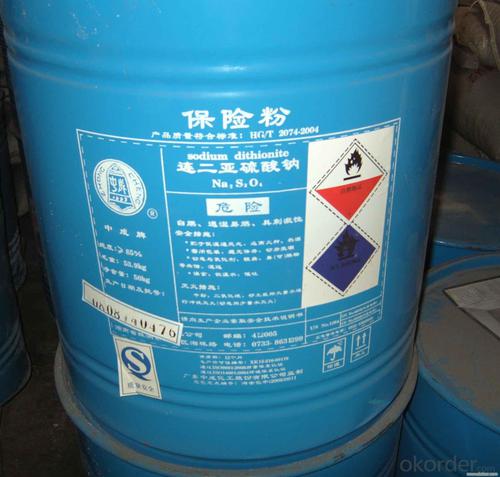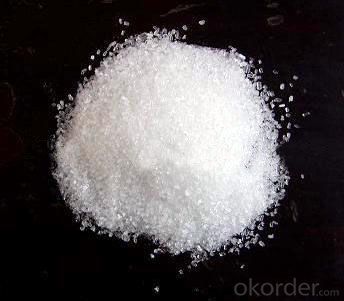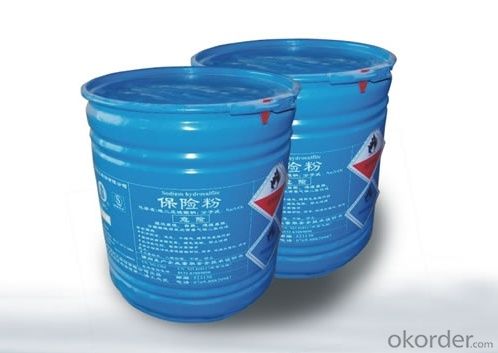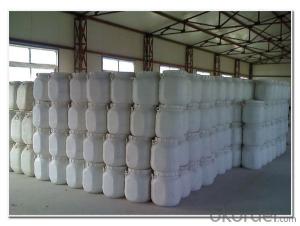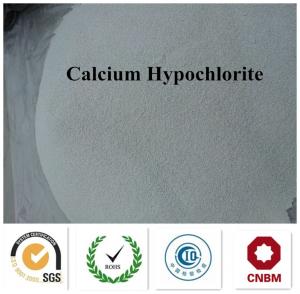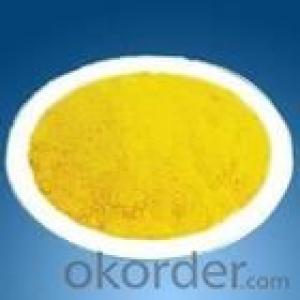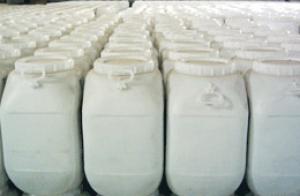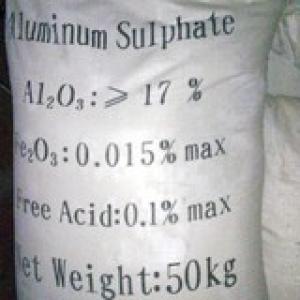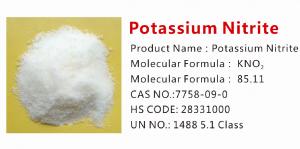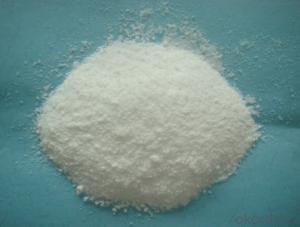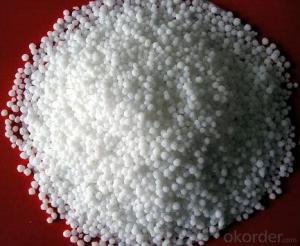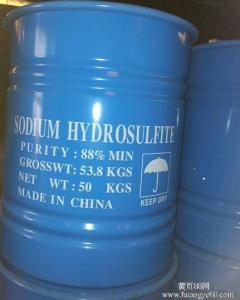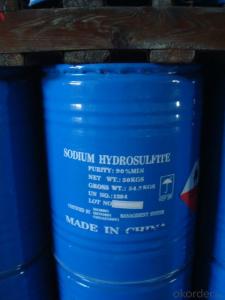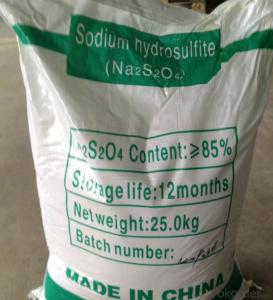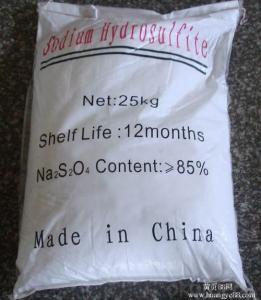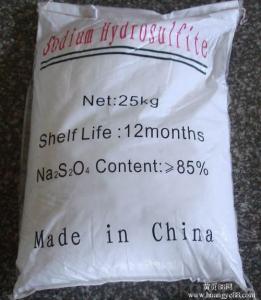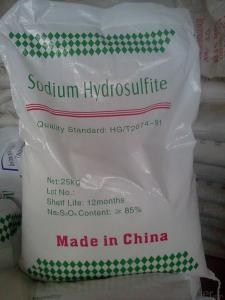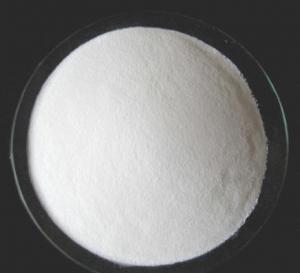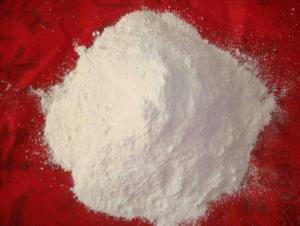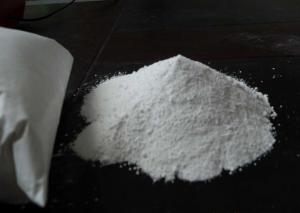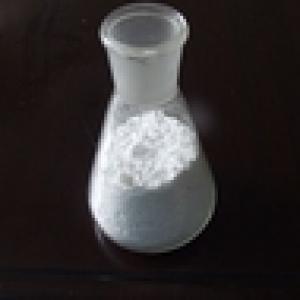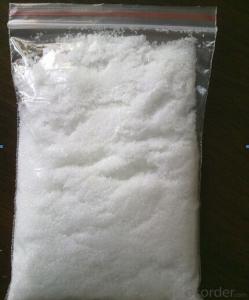Best Quality and Best Price of Sodium Hydrosulphite
- Loading Port:
- Qingdao
- Payment Terms:
- TT or LC
- Min Order Qty:
- 22 m.t.
- Supply Capability:
- 3000 m.t./month
OKorder Service Pledge
OKorder Financial Service
You Might Also Like
1.Structure of Sodium Hydrosulfite Description:
Commodity name: Sodium Hydrosulfite Na2S2O4 Sodium Hydrosulfite Sodium Dithionite Price
Molecular formula:Na2S2O4
Molecular weight:174
CAS Number 7775-14-6
H.S code 28311010
UN number 1384
Class 4.2
2.Main Features of Sodium Hydrosulfite:
It is a versatile chemical that's used in the manufacture of a variety of products we all use every day,
from photographic film to wine; from fine writing papers to leather goods; from colored fabrics to metal recovery.
While the applications for this chemical workhorse are as vast and as varied as the industries that use it,
in most cases, sodium hydrosulfite performs one of the following three roles:
1) As reducing agent, hydrosulfite chemically reduces othercomponents by donating an electron or electrons
2) As sulfonating agent, hydrosulfite adds sulfur to another chemical compound
3) As cation source, hydrosulfite adds a cation, or sodium, to a product system
3.Sodium Hydrosulfite Images
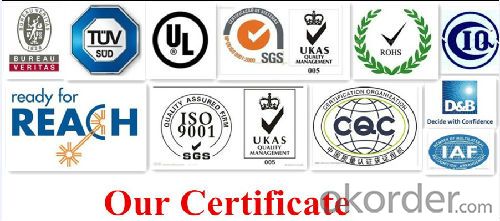
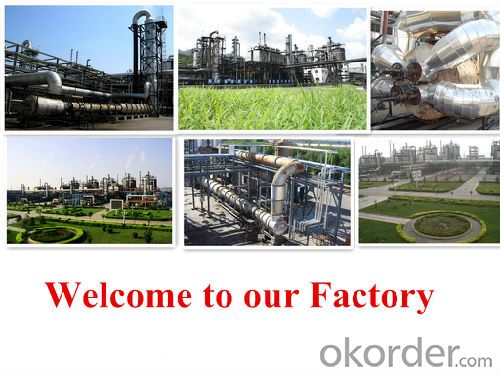

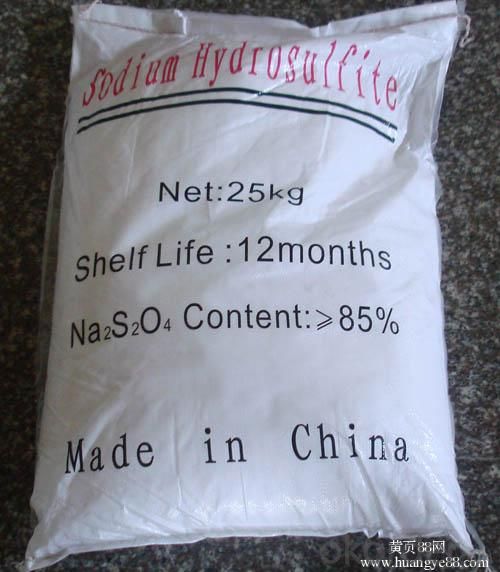
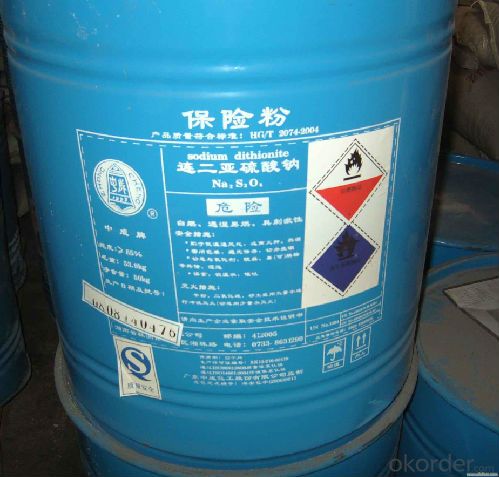
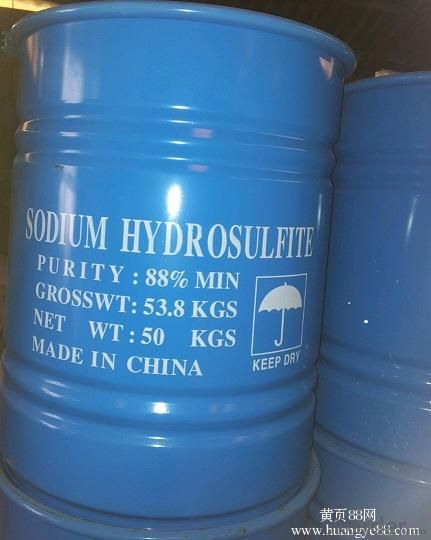
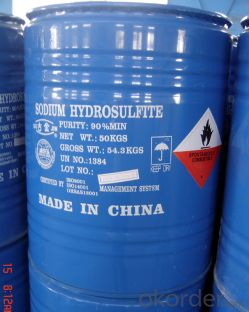
4.Sodium Hydrosulfite Speci
Standard:HG2932-1999
Index | Technical Grade HG/T 2074-2011 | Food Additive GB 22215-2008 | ||
Na2S2O4, | ≥ 90% | ≥ 88% | ≥ 85% | ≥ 88% |
Iron (Fe), | ≤20ppm | ≤ 20ppm | ≤ 20ppm | ≤ 20ppm |
Zinc (Zn), | ≤ 1ppm | ≤ 1ppm | ≤ 1ppm | ≤ 1ppm |
solution appearance | clear | clear | clear | clear |
EDTA, | / | / | / | qualified |
Arsenic(As), | / | / | / | ≤ 1ppm |
Other heavy metal( As Pb), | ≤ 1ppm | ≤ 1ppm | ≤ 1ppm | ≤ 1ppm |
Formate (As HCHO), | / | / | / | ≤ 0.05% |
water insolubles, | ≤ 0.05% | ≤ 0.05% | ≤ 0.05% | / |
Cadmium (Cd) | / | / | / | ≤ 2ppm |
Plumbum (Pb) | / | / | / | ≤ 5ppm |
5.FAQ
1)How many tons does your factory can supply each moth?
30000tons/month
2)How to quarantee the quality of the products?
you can arrange SGS&BV or other quality inspection.
3)How many days you need to pepare the cargo after we made the order?
within 30 days.
- Q: anybody here knows the difference of organic iron salt (ex. F.gluconate) vs inorganic (ex. F.sulfate)?
- It it's organic, then the anion (the negative ion) is the conjugate base of an organic acid. If it's inorganic, then the original acid was inorganic (like H2SO4 making sulphates).
- Q: Several kinds of inorganic salt food sources?
- Pepper, bamboo, bamboo, seaweed, lily, nuts, bread, dairy, beans, seaweed, kelp, kelp, Olives, cauliflower, amaranth, shepherd's purse, salted egg, noodles, fermented bean curd, tempeh, spinach, amaranth, spinach, coriander, fruit
- Q: CuMnFeNior ZnAlso metal calcium reacts with molecular hydrogen to form a compound. Which statement concerning this compound is not true?It's formula is CaH2it is ionicsolid at room tempwhen added to water, reacts to produce h2 gaswhen added to water, forms acidic solutionMy guess was going to be that it is not ionic, but i'm not 100% positive.Can anyone help me with these chemistry questions? Or atleast point me to some webpage that might help. Please and thank you.
- Only Zn compounds form colorless or white salts. The second question would be the last answer, which is false. It forms an alkaline solution when added to water.
- Q: Are plants absorbing water and inorganic salts only through root tip or wrong? The
- This is wrong.
- Q: Cells in the water, inorganic salts, protein, lipid, carbohydrate and nucleic acid six words how wrong this sentence
- Wrong in the compound
- Q: what is the function of the organic part of bone matrix?of the inorganic part(bone salts)?
- For the best answers, search on this site www.okorder You're a riot, I swear. It amazes me how many people completely miss your plays on words. I'd stick with the "in" organic food. You know, the really trendy stuff like chai tea. Stay away from old, tired standbys like pizza and hamburgers. Macaroni and cheese, though, is like the tuxedo or the little black dress. It never goes out of style.
- Q: Why are inorganic sodium salts much better soluble in ethanol than potassium salts?
- The reason seems to be : - Ionization potential of pottasium is lower than that of sodium ,thereore potassium salts are more polar as compared to sodium salts; - Potassium being more reactive than the sodium reacts faster withbwater,
- Q: People lack the inorganic salt will be what disease
- iron deficiency will lead to iron deficiency anemia, immunity decreased.
- Q: Please tell in your own language how water and inorganic salts are transported from the soil to the leaves.
- The roots of plants are usually divided into roots, lateral, small roots, small roots (roots, roots and roots) for the absorption of roots, the absorption of roots from the soil to absorb water and inorganic salts, through the transport organization to reach the xylem of the catheter, through The ducts are delivered to the various organs of the plant (including the leaves).
- Q: And what I specifically need are salts with Bromide, Chloride, Phospate and Carbonate ions.Thanks for any help.
- That list is near endless. There are countless inorganic cations and organic groups that can combine with these ions. Pretty much every metallic element in the periodic table will form cations with bromide and chloride. Not sure about phosphate, but most metals will bind with it. Carbonate will be trickier, as some ions are too acidic and will decompose the carbonate (iron(III) is an example, and it will form the oxide instead, liberating CO2 in the process). Aside from simple elemental ions, there are also polyatomic cations (such as ammonium) and lots of complexes that will form compounds with these anions.
Send your message to us
Best Quality and Best Price of Sodium Hydrosulphite
- Loading Port:
- Qingdao
- Payment Terms:
- TT or LC
- Min Order Qty:
- 22 m.t.
- Supply Capability:
- 3000 m.t./month
OKorder Service Pledge
OKorder Financial Service
Similar products
Hot products
Hot Searches



